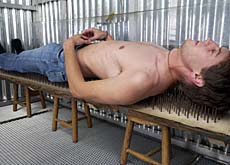Neuchâtel offers ultimate touching treat

A new exhibition is offering a unique “hands-on” experience by inviting visitors to touch everything on display.
Neuchâtel’s natural history museum has replaced its strict “hand off” signs with invitations to feel and touch a vast range of objects, from statues to a bed of nails.
“Here you have to touch everything,” museum director Christophe Dufour told swissinfo.
The moment you enter, it’s clear that a sensory treat lies ahead.
Visitors are asked to remove their shoes to allow the soles of their feet to come in contact with a range of textures.
In one section, they are challenged to make their way through a labyrinth where different trails are covered with different types of matting – with visitors having only their feet to guide them.
Small hairs
But the exhibition begins with an opportunity to touch objects with the hands, including varieties of wood and rock and samples of animal fur.
“The sense of touch tends to be neglected by humans, while the animal world is highly sensitive,” says Dufour.
“Fish and rodents are good examples. Yet a human’s body is covered by about five million small hairs – as many as a gorilla – and all of them are sensitive to the touch.”
Like previous temporary exhibitions at the museum, this one will appeal to people of all ages and is not only instructive – it’s also fun.
Bed of nails
For example there’s a bed of nails. Dufour admits that visitors invited to stretch out on the bed may not find it totally comfortable.
“But there’s absolutely no pain involved,” he explains. “The pressure of the body is spread on so many nails that you won’t be pierced.”
Next to this section, a curtained-off area invites visitors to slip their hands into sleeves and feel objects without actually seeing them. A particularly tricky example is a model of “The Thinker” by the French sculptor, Auguste Rodin.
“This is an extremely difficult exercise,” said Dufour. “You can spend five minutes trying to imagine what you are touching and be extremely surprised afterwards when you go behind the curtain to take a look.
“What is obvious to the eye is not so obvious to the touch.”
Sight and touch
This is further borne out by a box with a small aperture through which the visitor observes what appears to be a rectangular piece of wood.
But touching the wood while looking at it reveals it to be square-shaped, once again proving that sight sends more information to the human brain than the sense of touch.
The exhibition, which ends on January 4, was conceived by the Apex association of Belgium and has moved to Neuchâtel from the natural history museum in Brussels.
swissinfo, Richard Dawson in Neuchâtel
The exhibition starts with examples of wood and rock, all of them pleasing to the touch, alongside animal furs and skins.
The sense of touch tends to be neglected by humans, yet a human’s body is covered by about five million small hairs, all of them are sensitive to the touch.
Identifying a model of Rodin’s sculpture “The Thinker” is surprisingly difficult when relying solely on the sense of touch.
If visitors feel tired they can stretch out on a bed of nails – a painless experience!

In compliance with the JTI standards
More: SWI swissinfo.ch certified by the Journalism Trust Initiative
You can find an overview of ongoing debates with our journalists here. Please join us!
If you want to start a conversation about a topic raised in this article or want to report factual errors, email us at english@swissinfo.ch.